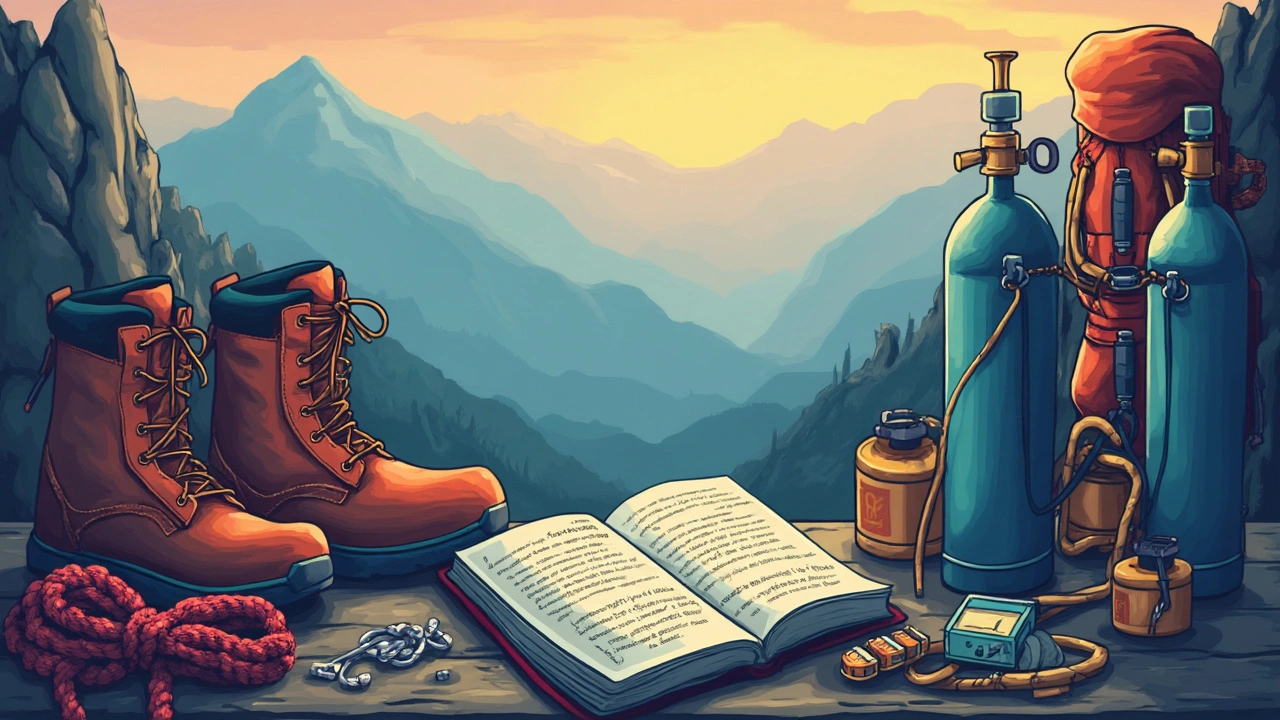Imagine you’ve spent months training for a mountain trek. You feel strong, determined, and nothing could stop you from reaching that summit. But halfway up, the air thins, your heart pounds, and suddenly it’s a struggle just to catch your breath. You’re not alone—at high altitudes, even the toughest adventurers can get hit by mountain sickness. The weird part? You might have run marathons at sea level, but at 4,000 meters above sea level, all bets are off. That’s when oxygen therapy isn’t just a nice-to-have; it can become a lifesaver. People love talking about hydration, pacing, or special snacks, but oxygen is the unsung hero in these situations. If you’ve ever wondered exactly how those oxygen tanks and concentrators help, or if they’re just a last resort for extreme cases, you’re in the right place.
Understanding Mountain Sickness and Why Oxygen Matters
Altitude can sneak up on you. Technically, mountain sickness starts kicking in when you go above 2,500 meters. The classic symptoms? Headache, nausea, dizziness, fatigue—like the universe's worst hangover, but without the fun night before. Around 25% to 40% of people climbing above 3,000 meters get mild acute mountain sickness (AMS). Advanced cases morph into high altitude cerebral edema (HACE) or high altitude pulmonary edema (HAPE), both of which can kill you if you’re not careful. What’s behind all this suffering? Hypoxia, or simply, not enough oxygen making it to your tissues.
Here's the science: As elevation rises, the air gets thinner. At 4,000 meters, the oxygen levels are about 60% of what you breathe at sea level. Your body scrambles to adapt by making you breathe faster and pumping your heart like you’ve sprinted a mile. Trouble is, that’s not always enough. Enter oxygen therapy—it’s a simple fix for a complex problem. More precisely, it boosts the amount of oxygen you breathe, so your blood can deliver what your brain and muscles desperately need.
Doctors didn’t just guess that oxygen helps. There’s data behind it. A 2020 meta-analysis published in High Altitude Medicine & Biology reviewed dozens of real-life high-altitude expeditions. It showed that oxygen therapy dramatically shortened recovery time in people with moderate and severe mountain sickness—often from days to just hours. The numbers speak for themselves. For example, oxygen flow rates of 2 to 4 liters per minute brought symptom scores down by at least 50% within four hours for most folks, a turnaround you’ll be grateful for when you’re curled up in a tent feeling miserable. And it’s not just for trekkers. Mountaineering medics use portable oxygen for helicopter pilots, ultramarathon runners, high-altitude construction crews, and even researchers at remote observatories.
| Altitude (meters) | O2 Saturation (sea-level healthy) | Approx. % Developing AMS |
|---|---|---|
| 2,500 | 95-98% | 10% |
| 3,000 | 92-95% | 25% |
| 4,000 | 85-90% | 40% |
| 5,500 | 75-80% | 60%+ |
No two people react the same way at altitude, and even pro athletes can get flattened. So when someone says, 'I’ve climbed higher without oxygen,' take it with a grain of salt—your genetics, hydration, and even last night’s sleep can change the game.

How Oxygen Therapy Is Used on the Mountain
So how does oxygen actually come into play once mountain sickness kicks in? Think of oxygen therapy in two flavors: supplemental (to buy you time or relieve moderate symptoms) and emergency rescue (when things head south fast). Let’s talk specifics.
In real-life expeditions, supplemental oxygen is delivered through a mask or nasal cannula hooked up to a cylinder or concentrator. The flow rate matters: 2 liters per minute is typical for mild symptoms, but someone struggling to stay conscious with severe altitude sickness might get bumped to 4 or 5 liters. Find yourself in a commercial trekking group climbing Kilimanjaro, Everest Base Camp, or the Andes? Chances are, guides carry lightweight oxygen systems for just this purpose. For mountaineers at high-altitude camps, using oxygen overnight can noticeably improve sleep quality, reduce headaches, and keep appetite steady. This isn't wishful thinking—a 2019 study from the International Society for Mountain Medicine found that using oxygen for even two to three hours per night at high camp cut severe AMS cases by 70%. That translates to fewer people who have to abort their climb during summit push.
Emergency use is heavier stuff. If someone’s oxygen saturation plummets (below 75-80% at high altitude) or they show signs of HAPE or HACE, the golden rule is: descend immediately, give oxygen, and keep them warm. Don’t wait for 'just one more night'. In these cases, high flow rates of 5-7 liters per minute can literally keep someone alive until evacuation. Some teams rig up portable hyperbaric chambers (imagine a high-tech sleeping bag you zip into) as a backup—the goal is always to increase the oxygen concentration in the air around the patient.
Packing all this into your kit isn’t as hard as you think. Modern oxygen concentrators are roughly the size of a large thermos and weigh just 3-5 pounds. They draw in thin mountain air and churn out concentrated oxygen—perfect for those long nights above 4,000 meters. Of course, bottled oxygen is still the standard for quick, high-rate applications, and you’ll see tanks on almost every guided expedition over 5,000 meters. But don’t forget the basics! Pulse oximeters (those tiny finger clips) give you instant readings on blood oxygen levels and are dirt cheap now—under $30 online. Always handy for quick decisions, especially when your head’s too foggy to trust your instincts.
Worried about overdoing it? It’s rare, but yes, too much oxygen for too long (especially above normal sea-level concentrations) can lead to oxygen toxicity. The practical risk on an expedition is low, since high flow rates are used for short bursts. The bigger risk is complacency—forgetting that oxygen is a band-aid, not a cure. Treating the cause still means stopping your climb, dropping to a safer altitude, and getting medical help if you need it. If someone suggests pushing on with just an oxygen tank and willpower, that’s asking for trouble.
For those who love practical tips, here’s a checklist for smart oxygen use on the mountain:
- Always check oxygen equipment before leaving base camp—better to find a leaky regulator on the ground than on the summit ridge.
- Keep tanks insulated and regulators dry—freezing temps can jam valves fast.
- Have spare masks/cannulas in your kit (more people forget these than you’d think).
- If symptoms start, stop ascent and monitor with a pulse oximeter—spiking oxygen needs can warn you before things turn critical.
- Remember, using oxygen for too long without descent can mask symptoms and lead to rapid worsening once oxygen runs out.
One last thing: attitudes are changing about using oxygen. Twenty years ago, climbers treated it like cheating—old-school Everest climbers bragged about 'going without.' Now, even elite teams pack rescue oxygen for emergencies. Ask any experienced mountain medic: they’d rather see a friend hugging an oxygen tank on the ride down than risking brain swelling on the slopes.

Who Needs Oxygen Therapy, and Are There Alternatives?
The big question is: who actually needs oxygen therapy, and is it for everyone? Let’s get real. Most healthy adults can adapt to moderate altitudes (up to about 3,500 meters) with gradual ascent, proper hydration, and rest days. That’s why tour operators build acclimatization days into trekking schedules—you’re literally training your body to squeeze more oxygen from thin air slower. But genetics and age play a role. For example, people with a history of altitude sickness, underlying lung conditions (like asthma or COPD), or heart issues should absolutely have an emergency oxygen plan in place. For kids, the elderly, or folks with compromised immunity, symptoms can appear earlier and hit harder.
Not everyone is eager to use oxygen at the first sign of discomfort, and honestly, most mild AMS cases resolve just with rest and proper acclimatization. But ignoring moderate-to-severe symptoms is risky—the slide from headache to delirium or pulmonary edema can be fast. Guides often use the Lake Louise Score (a recognized scale) to help decide. For example, a headache plus two other symptoms (like vomiting and fatigue) score high, pushing guides to start oxygen therapy and consider descent.
Let’s talk about alternatives. Acetazolamide (Diamox) is a favorite of mountain docs: it helps speed up acclimatization by making you pee off extra bicarbonate, triggering your body to breathe deeper and faster. The downside? It tastes metallic and can cause tingling in your fingers. Dexamethasone (a steroid) is used in emergencies for brain swelling but doesn’t help your body actually use more oxygen. Simple painkillers, hydration, and rest are mainstays, but once symptoms spiral, nothing matches pure O2 for rapid relief. That’s why almost every Himalayan rescue helicopter and high-altitude ER stocks oxygen—and why most big expedition guides insist their clients learn how to use the kit before they leave base camp.
Permanent solutions don’t exist—acclimatization works until you hit your personal redline. Some seasoned high-altitude porters and Sherpas have genetic tweaks (extra hemoglobin or altered mitochondrial enzymes) that help, but for most of us mere mortals, external oxygen is as close as it gets to a mountain hack. And yes, you’ll sometimes see athletes using oxygen rooms to simulate high-altitude training, but the effect is not the same as what you experience at 5,000 meters when your sleep is shallow and your brain is gasping for every bit of oxygen.
For travelers or climbers without access to medical gear, prevention is still king. Stick to the 'climb high, sleep low' rule, add rest days above 2,500 meters, eat well, and avoid alcohol or sedatives, since they depress your breathing. Consider packing a portable pulse oximeter and learn the warning signs—it could save you or a friend.
Here’s a quick comparison of therapies and their roles at altitude:
| Therapy | Best For | Rapid Symptom Relief | Preventative | Long-Term Solution |
|---|---|---|---|---|
| Oxygen Therapy | Moderate-Severe AMS, HACE, HAPE | Yes | No | No |
| Acetazolamide | Prevention and Mild AMS | Limited | Yes | No |
| Dexamethasone | Emergency (HACE) | Yes | No | No |
| Descent | All severity | Yes | Yes (if possible) | Yes |
If you’re likely to head above the clouds soon, don’t let the risks scare you—but do treat altitude with respect. The mountains have humbled plenty of fit, experienced people. Gear up right, listen to your body, and know that oxygen isn’t just a last-ditch rescue device. Used smartly, it means coming home with epic photos and stories, not a harrowing cautionary tale. High-altitude adventure should be about the thrill of the climb, not fighting for your next breath.


Matthew Platts
Man, you’re right – oxygen can be the literal lifeline when you’re fighting that thin‑air head‑spin. I’ve seen crews on Kilimanjaro pull a night‑time mask and bounce back in a few hours. The trick is to keep the flow steady, like 2‑3 L/min for mild symptoms, and don’t wait until you’re seeing stars. A quick sniff of pure O₂ can reset your brain’s oxygen debt and let you think clearly again. So pack that tiny concentrator, test it before the ascent, and you’ll be breathing easy when the summit calls.